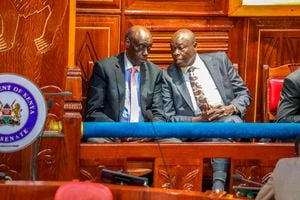Khoi and San receive historic payout for ‘traditional knowledge’

Members of the Khoisan community. Their descendants have begun to receive payouts for their traditional knowledge, from proceeds of sales of the globally famous ‘rooibos’ tea. AFP PHOTO / MUJAHID SAFODIEN
What you need to know:
- In the first payment of its kind, about US$720,000 has been paid to a trust as a percent of sales of the increasingly popular beverage.
- Rooibos, which is a Dutch-Afrikaans word meaning ‘red bush’, is a slender stalk-like plant which grows abundantly in the far south and south-western regions of Africa.
- Dried under the sun, the plant reddens and subsequently is cut into small pieces suitable for making a caffeine-free beverage.
Descendants of what may well be the oldest of the world’s ‘First Peoples’, the Khoi and San of south-western Africa, have begun to receive payouts for their traditional knowledge, from proceeds of sales of the globally famous ‘rooibos’ tea.
In the first payment of its kind, about US$720,000 has been paid to a trust as a percent of sales of the increasingly popular beverage.
Rooibos, which is a Dutch-Afrikaans word meaning ‘red bush’, is a slender stalk-like plant which grows abundantly in the far south and south-western regions of Africa.
Dried under the sun, the plant reddens and subsequently is cut into small pieces suitable for making a caffeine-free beverage.
Rooibos tea is catching on rapidly worldwide as health-conscious people seeking alternatives to traditional tea or coffee buy up the aromatic and health-supporting beverage.
In a historic move, the burgeoning rooibos industry made its first payout to the National Khoi and San Council and the South African San Council (NKSCSASC) this week.
The payment is part of an Access and Benefit-sharing (ABS) agreement, signed between representatives of those with Khoi and San heritage and genetics, and rooibos industry players, in 2019.
South Africa requires all who trade in indigenous biological resources, such as rooibos, to share the benefits of this trade with traditional knowledge-holders in a fair and equitable way, in terms of S Africa’s commitments under the Nagoya Protocol.
The aim of the benefit-sharing of rooibos revenues is to contribute to poverty-reduction, food security, social development and biodiversity conservation.
The few remaining ‘traditional San and Khoi’, along with many descendants of these groups with mixed heritage, tend to still live on the fringes of modern society, both physically speaking and economically so.
Their communities are among the most impoverished in the country.
There are some hundreds to a few thousand people, some living in Botswana, who are considered ‘pure’ Khoi and San (the group names being largely interchangeable), with many tens of thousands of mixed-heritage descendants in Botswana, on the eastern fringes of Namibia and in the northern and north-western semi-desert parts of South Africa.
Until a generation or two ago, San and Khoi communities were still migratory hunter-gatherers, with a plant knowledge-based system that includes hundreds of healing plants unique to the region they now and traditionally occupied.
Once, before other tribal groupings of central Africa arrived in South Africa, the San and Khoi had lived in this part of Africa since pre-historical times, their ancestors’ caves, ornaments and bones found in archeological digs along South Africa’s south-eastern coastline.
These archeological sites have revealed some of the oldest modern human artifacts found, including carefully carved sea shells and ostrich shells, made with extreme care to be decorative, as arm bands, or necklaces or other adornment.
Martin Bergh, Chairperson of the South African Rooibos Council (SARC), confirmed that the 2019 agreement had resulted in the first of what should be a steady stream of funds to Khoi and San beneficiaries.
In terms of the agreement, the rooibos industry, represented by SARC, will pay out 1.5 percent of the farm gate price of rooibos into a trust annually.
The Rooibos ABS agreement, as the initiative is called, is a first-of-its-kind in the world.
In 2014 the Khoi and San were recognised by the South African government as the rightful traditional knowledge-holders of rooibos, among many other pharmaceutically and nutritionally significant plants.
Of particular interest for commercial reasons are also sutherlandia, a natural ‘antibiotic’, hoodia, a rare appetite-suppressant with major European interests wanting to develop a supply to the ‘slimming market’, the African wild potato as used by some traditionally to treat particular cancers, and artemisia, widely used in the region and beyond to treat malaria and fevers.
It is hoped by campaigners for First Peoples’ rights that these other traditionally used plants, among an estimated 1,500 known to San and Khoi traditional healers, will also attract similar benefits to the knowledge-holding communities, though none is as developed as rooibos in terms of a growing international market.
An annual report, detailing the distribution of funds, will be submitted to the government to ensure complete transparency and accountability.
The payouts ‘complete an historic cycle’ which began with the Khoi and San being pushed out by more warlike tribes from the north, later to be literally hunted down, with a bounty on their heads as so-called ‘stock thieves’, by the first Dutch settlers in the Cape who did not understand that the Khoi and San traditionally have no concepts of property ownership.
When the Khoi and San hunted the white settlers’ cattle and sheep, a price was put on their heads, at the time, a crown, which was paid on production to authorities of a corpse.





